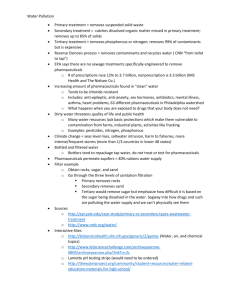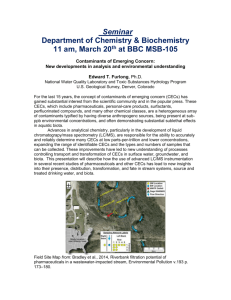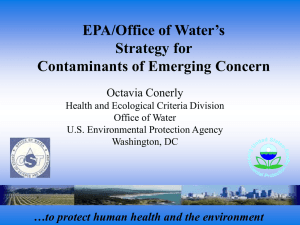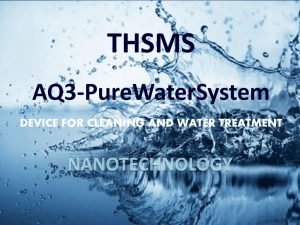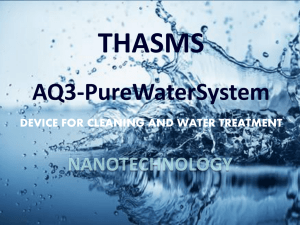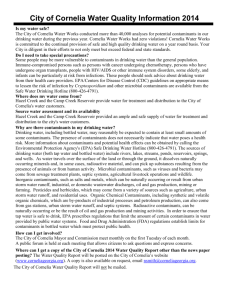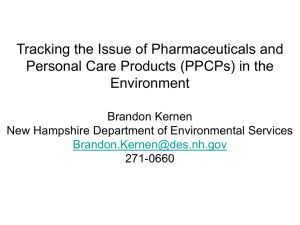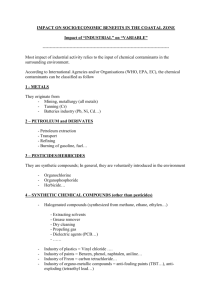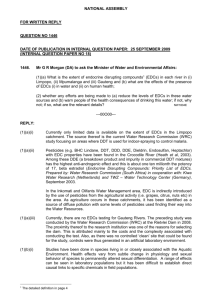Overview of AwwaRF Project 3085 Findings
advertisement
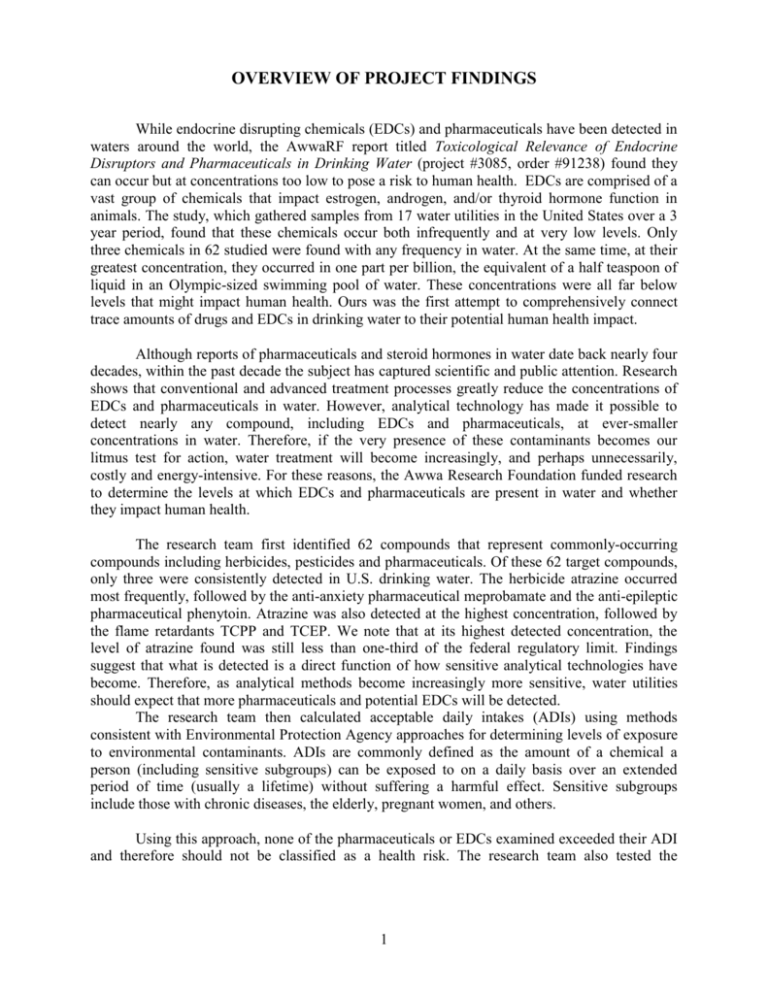
OVERVIEW OF PROJECT FINDINGS While endocrine disrupting chemicals (EDCs) and pharmaceuticals have been detected in waters around the world, the AwwaRF report titled Toxicological Relevance of Endocrine Disruptors and Pharmaceuticals in Drinking Water (project #3085, order #91238) found they can occur but at concentrations too low to pose a risk to human health. EDCs are comprised of a vast group of chemicals that impact estrogen, androgen, and/or thyroid hormone function in animals. The study, which gathered samples from 17 water utilities in the United States over a 3 year period, found that these chemicals occur both infrequently and at very low levels. Only three chemicals in 62 studied were found with any frequency in water. At the same time, at their greatest concentration, they occurred in one part per billion, the equivalent of a half teaspoon of liquid in an Olympic-sized swimming pool of water. These concentrations were all far below levels that might impact human health. Ours was the first attempt to comprehensively connect trace amounts of drugs and EDCs in drinking water to their potential human health impact. Although reports of pharmaceuticals and steroid hormones in water date back nearly four decades, within the past decade the subject has captured scientific and public attention. Research shows that conventional and advanced treatment processes greatly reduce the concentrations of EDCs and pharmaceuticals in water. However, analytical technology has made it possible to detect nearly any compound, including EDCs and pharmaceuticals, at ever-smaller concentrations in water. Therefore, if the very presence of these contaminants becomes our litmus test for action, water treatment will become increasingly, and perhaps unnecessarily, costly and energy-intensive. For these reasons, the Awwa Research Foundation funded research to determine the levels at which EDCs and pharmaceuticals are present in water and whether they impact human health. The research team first identified 62 compounds that represent commonly-occurring compounds including herbicides, pesticides and pharmaceuticals. Of these 62 target compounds, only three were consistently detected in U.S. drinking water. The herbicide atrazine occurred most frequently, followed by the anti-anxiety pharmaceutical meprobamate and the anti-epileptic pharmaceutical phenytoin. Atrazine was also detected at the highest concentration, followed by the flame retardants TCPP and TCEP. We note that at its highest detected concentration, the level of atrazine found was still less than one-third of the federal regulatory limit. Findings suggest that what is detected is a direct function of how sensitive analytical technologies have become. Therefore, as analytical methods become increasingly more sensitive, water utilities should expect that more pharmaceuticals and potential EDCs will be detected. The research team then calculated acceptable daily intakes (ADIs) using methods consistent with Environmental Protection Agency approaches for determining levels of exposure to environmental contaminants. ADIs are commonly defined as the amount of a chemical a person (including sensitive subgroups) can be exposed to on a daily basis over an extended period of time (usually a lifetime) without suffering a harmful effect. Sensitive subgroups include those with chronic diseases, the elderly, pregnant women, and others. Using this approach, none of the pharmaceuticals or EDCs examined exceeded their ADI and therefore should not be classified as a health risk. The research team also tested the 1 estrogenicity levels in finished drinking waters and determined that they were below the reporting limit. In comparison, several food and beverage items had far greater estrogenicity. The food/beverage items were included in this study only to provide a reference point for relative source contributions. This was not a formal statistically based study and only a few of each type of product were evaluated. The remediation of ultra-trace organic contaminants in drinking water is costly and may not lead to significant benefits in protecting public health. Even the most advanced and costly water treatment processes will not be able to remove all contaminants to less than the detection limit of the most sensitive procedures. Given the sensitivity of detection, utilities must try to help the public and key stakeholders understand that the presence of a compound in trace concentrations does not necessarily represent a health risk. Conveying risks related to this class of contaminants is no different than communicating with the public about the presence of other contaminants detected in water supplies. Utilities in the United States should also stay abreast of developments within the federal and state regulatory agencies. The EPA is aware of the most recent developments in trace water contaminants and already has programs in place to protect public health. The EPA has made the processes for evaluation of unregulated contaminants transparent and provides opportunity for public comment. Without question, the detection of pharmaceuticals and hormones in drinking water is likely to cause concern about the safety of drinking water supplies. A number of factors could fuel this concern including that the source of many of these compounds is primarily through human waste, the perception that people are being medicated unknowingly, and that these chemicals could cause any number of health effects including cancer and developmental effects. Because of this, it is critical that the levels of exposure be placed into proper context. The reality is that nearly any chemical known to humans could be detected in water using the most modern and sensitive of analytical instrumentation.. Pharmaceuticals, hormones, and other chemicals in trace quantities are, and will continue to be, detectable in water. To make wise use of our economic and natural resources, these emerging contaminants of concern must be considered through the same mechanisms that are used to regulate other water contaminants. 2

